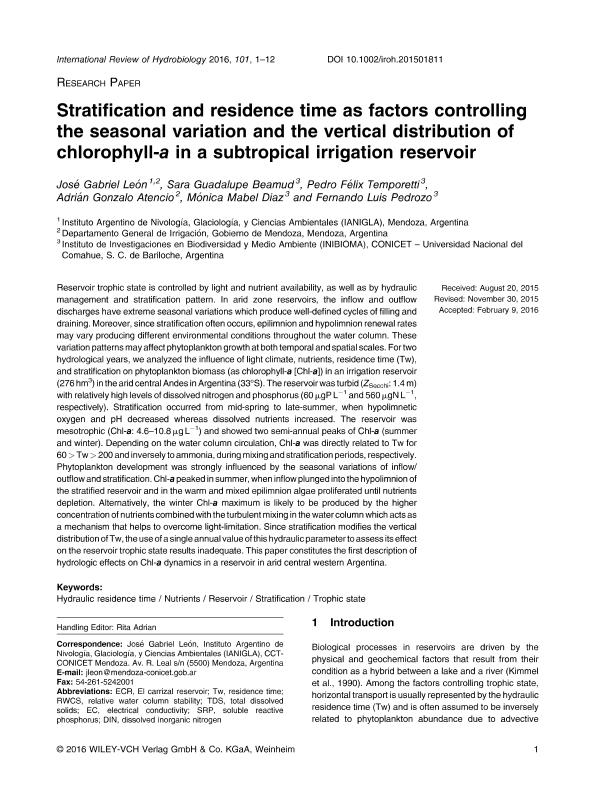Mostrar el registro sencillo del ítem
dc.contributor.author
León, José Gabriel

dc.contributor.author
Beamud, Sara Guadalupe

dc.contributor.author
Temporetti, Pedro Felix

dc.contributor.author
Atencio, Adrian Gonzalo

dc.contributor.author
Diaz, Monica Mabel

dc.contributor.author
Pedrozo, Fernando Luis

dc.date.available
2020-04-17T20:49:24Z
dc.date.issued
2016-02
dc.identifier.citation
León, José Gabriel; Beamud, Sara Guadalupe; Temporetti, Pedro Felix; Atencio, Adrian Gonzalo; Diaz, Monica Mabel; et al.; Stratification and residence time as factors controlling the seasonal variation and the vertical distribution of chlorophyll‐a in a subtropical irrigation reservoir; Wiley VCH Verlag; International Review of Hydrobiology; 101; 1-2; 2-2016; 1-12
dc.identifier.issn
1434-2944
dc.identifier.uri
http://hdl.handle.net/11336/102988
dc.description.abstract
Reservoir trophic state is controlled by light and nutrient availability, as well as by hydraulic management and stratification pattern. In arid zone reservoirs, the inflow and outflow discharges have extreme seasonal variations which produce well‐defined cycles of filling and draining. Moreover, since stratification often occurs, epilimnion and hypolimnion renewal rates may vary producing different environmental conditions throughout the water column. These variation patterns may affect phytoplankton growth at both temporal and spatial scales. For two hydrological years, we analyzed the influence of light climate, nutrients, residence time (Tw), and stratification on phytoplankton biomass (as chlorophyll‐a [Chl‐a]) in an irrigation reservoir (276 hm3) in the arid central Andes in Argentina (33°S). The reservoir was turbid (ZSecchi: 1.4 m) with relatively high levels of dissolved nitrogen and phosphorus (60 μgP L−1 and 560 μgN L−1, respectively). Stratification occurred from mid‐spring to late‐summer, when hypolimnetic oxygen and pH decreased whereas dissolved nutrients increased. The reservoir was mesotrophic (Chl‐a: 4.6–10.8 μg L−1) and showed two semi‐annual peaks of Chl‐a (summer and winter). Depending on the water column circulation, Chl‐a was directly related to Tw for 60 > Tw > 200 and inversely to ammonia, during mixing and stratification periods, respectively. Phytoplankton development was strongly influenced by the seasonal variations of inflow/outflow and stratification. Chl‐a peaked in summer, when inflow plunged into the hypolimnion of the stratified reservoir and in the warm and mixed epilimnion algae proliferated until nutrients depletion. Alternatively, the winter Chl‐a maximum is likely to be produced by the higher concentration of nutrients combined with the turbulent mixing in the water column which acts as a mechanism that helps to overcome light‐limitation. Since stratification modifies the vertical distribution of Tw, the use of a single annual value of this hydraulic parameter to assess its effect on the reservoir trophic state results inadequate. This paper constitutes the first description of hydrologic effects on Chl‐a dynamics in a reservoir in arid central western Argentina.
dc.format
application/pdf
dc.language.iso
eng
dc.publisher
Wiley VCH Verlag

dc.rights
info:eu-repo/semantics/openAccess
dc.rights.uri
https://creativecommons.org/licenses/by-nc-sa/2.5/ar/
dc.subject
HYDRAULIC RESIDENCE TIME
dc.subject
NUTRIENTS
dc.subject
RESERVOIR
dc.subject
TROPHIC STATE
dc.subject.classification
Otras Ciencias de la Tierra y relacionadas con el Medio Ambiente

dc.subject.classification
Ciencias de la Tierra y relacionadas con el Medio Ambiente

dc.subject.classification
CIENCIAS NATURALES Y EXACTAS

dc.title
Stratification and residence time as factors controlling the seasonal variation and the vertical distribution of chlorophyll‐a in a subtropical irrigation reservoir
dc.type
info:eu-repo/semantics/article
dc.type
info:ar-repo/semantics/artículo
dc.type
info:eu-repo/semantics/publishedVersion
dc.date.updated
2020-03-20T13:43:22Z
dc.journal.volume
101
dc.journal.number
1-2
dc.journal.pagination
1-12
dc.journal.pais
Alemania

dc.journal.ciudad
Weinheim
dc.description.fil
Fil: León, José Gabriel. Consejo Nacional de Investigaciones Científicas y Técnicas. Centro Científico Tecnológico Conicet - Mendoza. Instituto Argentino de Nivología, Glaciología y Ciencias Ambientales. Provincia de Mendoza. Instituto Argentino de Nivología, Glaciología y Ciencias Ambientales. Universidad Nacional de Cuyo. Instituto Argentino de Nivología, Glaciología y Ciencias Ambientales; Argentina
dc.description.fil
Fil: Beamud, Sara Guadalupe. Consejo Nacional de Investigaciones Científicas y Técnicas. Centro Científico Tecnológico Conicet - Patagonia Norte. Instituto de Investigaciones en Biodiversidad y Medioambiente. Universidad Nacional del Comahue. Centro Regional Universidad Bariloche. Instituto de Investigaciones en Biodiversidad y Medioambiente; Argentina
dc.description.fil
Fil: Temporetti, Pedro Felix. Consejo Nacional de Investigaciones Científicas y Técnicas. Centro Científico Tecnológico Conicet - Patagonia Norte. Instituto de Investigaciones en Biodiversidad y Medioambiente. Universidad Nacional del Comahue. Centro Regional Universidad Bariloche. Instituto de Investigaciones en Biodiversidad y Medioambiente; Argentina
dc.description.fil
Fil: Atencio, Adrian Gonzalo. Consejo Nacional de Investigaciones Científicas y Técnicas. Centro Científico Tecnológico Conicet - Mendoza. Instituto Argentino de Nivología, Glaciología y Ciencias Ambientales. Provincia de Mendoza. Instituto Argentino de Nivología, Glaciología y Ciencias Ambientales. Universidad Nacional de Cuyo. Instituto Argentino de Nivología, Glaciología y Ciencias Ambientales; Argentina
dc.description.fil
Fil: Diaz, Monica Mabel. Consejo Nacional de Investigaciones Científicas y Técnicas. Centro Científico Tecnológico Conicet - Patagonia Norte. Instituto de Investigaciones en Biodiversidad y Medioambiente. Universidad Nacional del Comahue. Centro Regional Universidad Bariloche. Instituto de Investigaciones en Biodiversidad y Medioambiente; Argentina
dc.description.fil
Fil: Pedrozo, Fernando Luis. Consejo Nacional de Investigaciones Científicas y Técnicas. Centro Científico Tecnológico Conicet - Patagonia Norte. Instituto de Investigaciones en Biodiversidad y Medioambiente. Universidad Nacional del Comahue. Centro Regional Universidad Bariloche. Instituto de Investigaciones en Biodiversidad y Medioambiente; Argentina
dc.journal.title
International Review of Hydrobiology

dc.relation.alternativeid
info:eu-repo/semantics/altIdentifier/doi/http://dx.doi.org/10.1002/iroh.201501811
dc.relation.alternativeid
info:eu-repo/semantics/altIdentifier/url/https://onlinelibrary.wiley.com/doi/abs/10.1002/iroh.201501811
Archivos asociados
